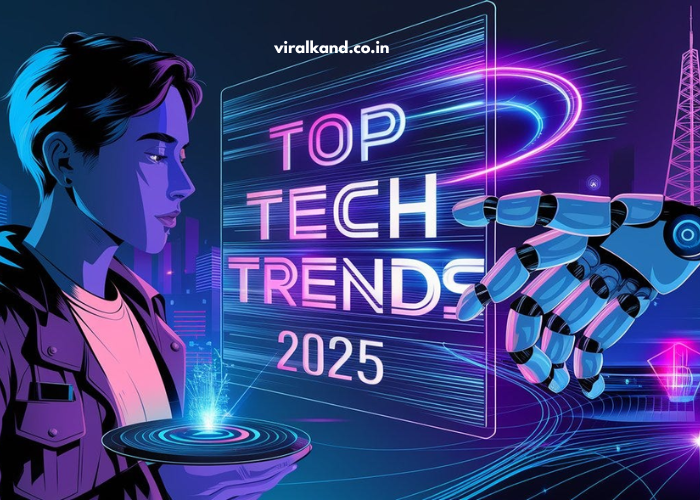The world of technology is evolving at an unprecedented pace. Every year, new innovations and trends shape industries, impact businesses, and alter the way we live. As we embark on another year of transformation, understanding the latest tech trends is essential for staying ahead of the curve. Whether you are a tech enthusiast, a business leader, or someone looking to optimize your daily life, knowing what’s coming next can provide a significant advantage.
This article will delve into the most crucial tech trends you need to know about this year. From artificial intelligence and machine learning advancements to the growing influence of blockchain, here’s a breakdown of what you can expect to see shaping the technological landscape in the near future.
1. Artificial Intelligence (AI) and Machine Learning (ML) Advancements
The Rise of Generative AI
Artificial intelligence has been steadily advancing for years, but this year, generative AI is poised to take the spotlight. Generative AI refers to systems that can generate new content, such as text, images, music, and even videos, based on the data they have been trained on. Tools like OpenAI’s GPT-4, MidJourney, and DALL·E are excellent examples of generative AI already being used for various purposes.
These technologies are not only revolutionizing creative industries but are also being incorporated into businesses for content creation, automation, and personalized customer experiences. As businesses leverage AI to enhance efficiency, creativity, and innovation, AI-powered chatbots, content generation tools, and automated design processes will become more commonplace.
AI in Healthcare
AI’s impact on healthcare continues to grow, with AI-driven technologies helping improve diagnostic accuracy, patient care, and drug discovery. Machine learning algorithms are now being used to predict diseases, personalize treatments, and streamline administrative tasks. AI models can analyze large sets of medical data to identify patterns that might be overlooked by human doctors, significantly improving patient outcomes.
This year, expect an increase in AI-powered medical devices, robotic surgeries, and predictive healthcare tools that can save lives and reduce costs in the long term.
2. Quantum Computing: Paving the Path for the Future
Quantum computing is another technology that is taking center stage in 2025. Unlike traditional computers that use binary data (0s and 1s), quantum computers utilize quantum bits (qubits) that can represent multiple states at once, enabling them to perform calculations exponentially faster.
While still in its early stages, major players in the tech industry, such as IBM, Google, and Microsoft, are pouring significant investments into quantum computing. In the coming years, quantum computers could solve complex problems related to cryptography, material science, climate change, and artificial intelligence—tasks that current supercomputers struggle to handle.
This year, breakthroughs in quantum hardware, quantum algorithms, and software development will bring us closer to realizing the full potential of quantum computing.
3. Blockchain and Decentralized Finance (DeFi)
Blockchain Beyond Cryptocurrency
Blockchain technology has been primarily associated with cryptocurrencies, but its potential goes far beyond that. This year, we are likely to see blockchain revolutionizing industries like supply chain management, digital identity verification, and even voting systems.
By enabling secure, transparent, and decentralized record-keeping, blockchain can provide solutions to many existing inefficiencies. For example, blockchain can improve transparency in supply chains, ensuring that goods are sourced ethically and reach consumers in a timely manner.
Moreover, decentralized finance (DeFi) continues to disrupt the traditional financial system by enabling peer-to-peer financial transactions without intermediaries like banks. DeFi protocols are growing rapidly, and innovations in this space could alter the future of finance, lending, and insurance.
NFTs and the Metaverse
Non-fungible tokens (NFTs) remain relevant in 2025, with artists, creators, and businesses adopting this technology to represent ownership of unique digital assets. The role of NFTs in the metaverse is expanding, where virtual spaces and economies are built. The metaverse is expected to evolve into a more immersive, integrated, and interoperable environment, offering new ways for people to interact, socialize, and transact online.
Businesses are investing heavily in metaverse-related technologies, and industries like gaming, real estate, and entertainment are already seeing the effects. This year, watch for increased adoption of VR headsets and more realistic virtual environments that bring us closer to an integrated digital universe.
4. 5G and Next-Generation Connectivity
Ultra-Fast Networks Powering Innovation
5G technology is here to stay, and in 2025, its implementation will accelerate. With speeds up to 100 times faster than 4G, 5G offers lower latency and higher bandwidth, making it ideal for a wide range of applications, including autonomous vehicles, smart cities, and industrial automation.
This year, 5G will enable new use cases in IoT (Internet of Things) devices, healthcare, and smart homes. As the rollout of 5G networks expands globally, businesses and individuals will have access to faster, more reliable internet connections that will transform how we work and live.
The Impact on Industry 4.0
Industry 4.0 refers to the integration of digital technologies such as IoT, AI, and automation into manufacturing processes. 5G connectivity will be a driving force behind Industry 4.0, enabling factories and warehouses to operate more efficiently with real-time data processing, remote monitoring, and advanced robotics.
With the improved capabilities of 5G, industries will experience faster decision-making, predictive maintenance, and enhanced automation, making production lines more adaptable and cost-effective.
5. Autonomous Vehicles and Electric Mobility
Self-Driving Cars and the Future of Transportation
Autonomous vehicles (AVs) are set to become a common sight on roads this year. Advances in AI, computer vision, and sensor technology are making self-driving cars safer, more efficient, and more reliable. Major automakers and tech companies like Tesla, Waymo, and Uber are heavily investing in autonomous vehicle technologies.
This year, expect to see further regulatory developments and more pilot programs testing AVs in cities. As safety standards improve and public confidence in these technologies grows, autonomous vehicles will continue their march toward mass adoption.
Electric Mobility and Sustainable Transportation
Alongside autonomous vehicles, electric vehicles (EVs) are becoming more popular as governments and businesses push for sustainable transportation solutions. With environmental concerns mounting, the shift from gas-powered cars to EVs is gaining momentum. This year, the number of EVs on the road is expected to increase, with more affordable models and better charging infrastructure being developed.
Additionally, electric bikes, scooters, and buses are gaining traction in urban areas, offering eco-friendly alternatives to traditional modes of transport. As EV adoption grows, innovations in battery technology will also drive significant improvements in range, charging speed, and overall performance.
6. Cybersecurity: Protecting the Digital Frontier
The Rise of AI-Driven Cybersecurity
With cyber threats becoming more sophisticated, cybersecurity is an area of increasing concern. This year, the cybersecurity industry will continue to innovate with the help of AI and machine learning to combat evolving threats. AI-powered security systems can analyze vast amounts of data to detect anomalies, identify potential vulnerabilities, and respond to cyberattacks in real-time.
As cybercriminals become more adept at exploiting vulnerabilities, AI will play a critical role in securing everything from personal data to enterprise systems. In 2025, businesses will increasingly turn to AI-based cybersecurity solutions to safeguard their operations, protect sensitive information, and prevent data breaches.
Zero Trust Architecture
Zero trust security models, where every user and device is assumed to be untrustworthy until verified, are gaining traction. By implementing this model, organizations can ensure that only authorized users and devices can access their networks, thereby reducing the risk of insider threats and external attacks.
This year, we can expect wider adoption of zero trust architectures across industries, as businesses prioritize strengthening their cybersecurity posture in the face of rising threats.
7. Edge Computing and IoT Integration
Moving Data Processing Closer to the Edge
Edge computing is a technology that brings data processing closer to where it’s generated, rather than relying on centralized cloud servers. This reduces latency and bandwidth usage, making it ideal for real-time applications such as autonomous vehicles, remote monitoring, and industrial automation.
As IoT devices proliferate across industries—from smart homes to healthcare and manufacturing—the need for edge computing will continue to grow. In 2025, more organizations will adopt edge computing to improve the performance and scalability of their IoT solutions.
Smart Cities and Smart Homes
The integration of IoT with edge computing is also paving the way for smarter cities and homes. Cities are leveraging IoT sensors, smart streetlights, and traffic management systems to improve urban living and reduce congestion. At the same time, smart homes are becoming more connected, with devices such as thermostats, security cameras, and lighting systems becoming part of an integrated ecosystem.
This year, we can expect smarter cities and homes to become more efficient and connected, driven by advances in IoT and edge computing technologies.
8. Augmented Reality (AR) and Virtual Reality (VR)
Enhanced Immersive Experiences
AR and VR technologies are continuing to evolve, with applications ranging from gaming and entertainment to education, healthcare, and retail. This year, AR and VR are expected to become more immersive, with improved hardware, more realistic environments, and expanded use cases.
For example, VR is being used for training simulations in fields like medicine and aviation, while AR is transforming retail by allowing customers to try products virtually before making a purchase. In 2025, the demand for immersive experiences will only grow as both AR and VR technologies become more mainstream.
AR/VR in Workplaces and Remote Collaboration
As remote work continues to be a fixture of the modern workplace, AR and VR are finding their place in improving collaboration and communication. VR meetings and AR-based remote assistance are becoming increasingly popular, offering more interactive and engaging ways to connect with colleagues across distances.
Conclusion: Embrace the Future of Technology
The technological trends highlighted in this article are just the tip of the iceberg. The rapid advancements in AI, quantum computing, blockchain, and many other areas will continue to reshape industries and redefine our everyday experiences. Whether it’s improving healthcare with AI, transforming transportation with autonomous vehicles, or creating new immersive digital environments, the future of technology is incredibly exciting.
Staying informed about these trends and understanding their potential will empower businesses, individuals, and governments to leverage technology effectively in 2025 and beyond. As we move forward, the convergence of these innovations will continue to push the boundaries of what’s possible, offering new opportunities and challenges along the way.
By keeping an eye on these top tech trends, you’ll be better positioned to take advantage of the opportunities they present, ensuring you remain at the forefront of technological innovation in the coming year.




